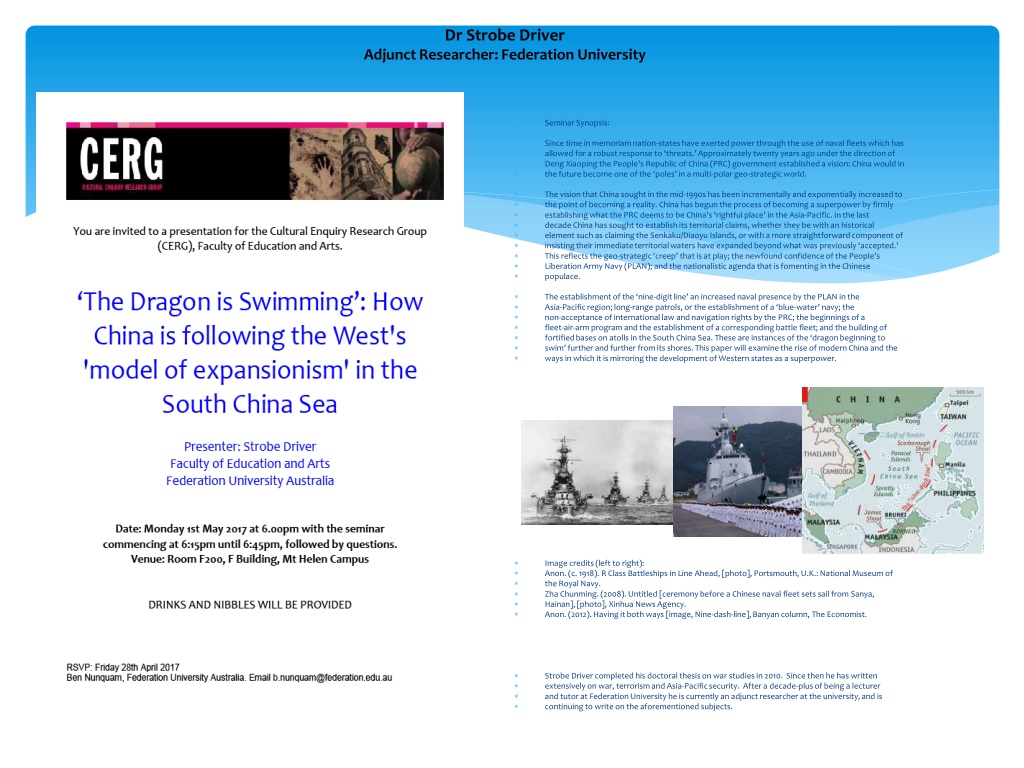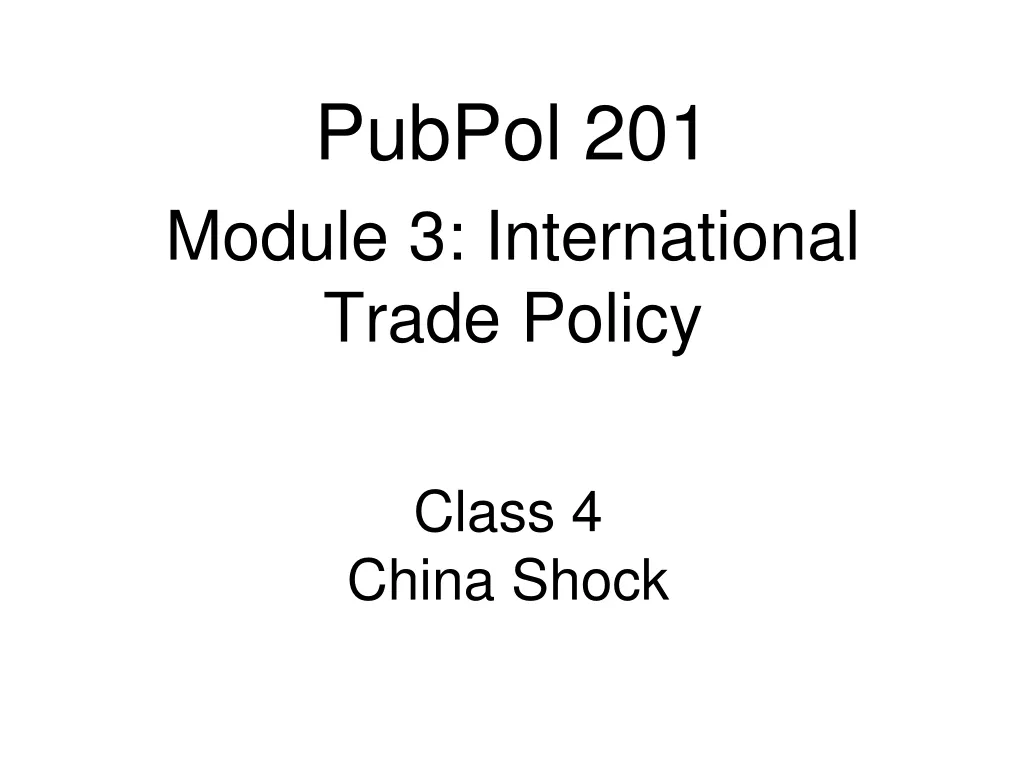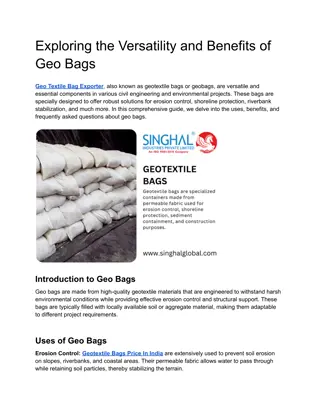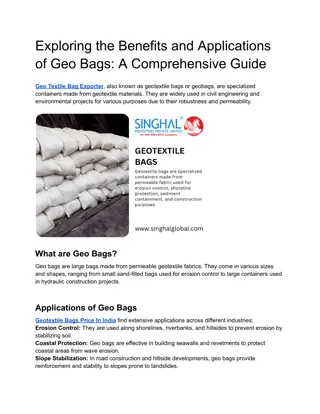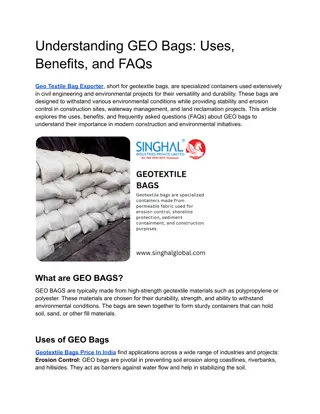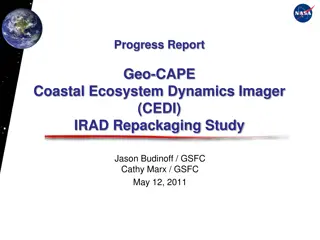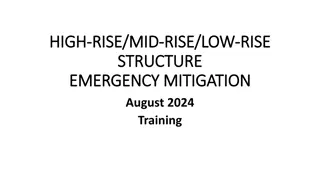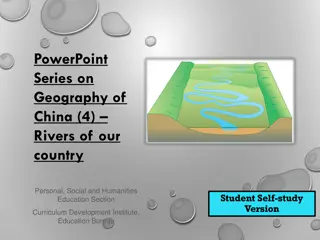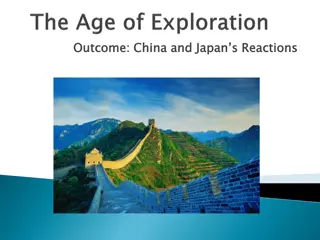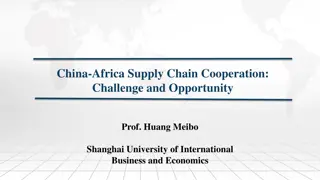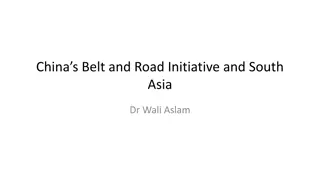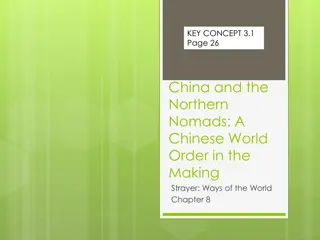Rise of Modern China: A Geo-Strategic Analysis
This paper delves into China's trajectory towards superpower status, examining its naval expansion, territorial claims, and nationalistic agenda. Dr. Strobe Driver, an adjunct researcher at Federation University, discusses China's growing influence in the Asia-Pacific region and its strategic parallels with Western superpowers.
Download Presentation

Please find below an Image/Link to download the presentation.
The content on the website is provided AS IS for your information and personal use only. It may not be sold, licensed, or shared on other websites without obtaining consent from the author.If you encounter any issues during the download, it is possible that the publisher has removed the file from their server.
You are allowed to download the files provided on this website for personal or commercial use, subject to the condition that they are used lawfully. All files are the property of their respective owners.
The content on the website is provided AS IS for your information and personal use only. It may not be sold, licensed, or shared on other websites without obtaining consent from the author.
E N D
Presentation Transcript
Dr Strobe Driver Adjunct Researcher: Federation University Seminar Synopsis: Since time in memoriam nation-states have exerted power through the use of naval fleets which has allowed for a robust response to threats. Approximately twenty years ago under the direction of Deng Xiaoping the People s Republic of China (PRC) government established a vision: China would in the future become one of the poles in a multi-polar geo-strategic world. The vision that China sought in the mid-1990s has been incrementally and exponentially increased to the point of becoming a reality. China has begun the process of becoming a superpower by firmly establishing what the PRC deems to be China s rightful place in the Asia-Pacific. In the last decade China has sought to establish its territorial claims, whether they be with an historical element such as claiming the Senkaku/Diaoyu Islands, or with a more straightforward component of insisting their immediate territorial waters have expanded beyond what was previously accepted. This reflects the geo-strategic creep that is at play; the newfound confidence of the People s Liberation Army Navy (PLAN); and the nationalistic agenda that is fomenting in the Chinese populace. The establishment of the nine-digit line an increased naval presence by the PLAN in the Asia-Pacific region; long-range patrols, or the establishment of a blue-water navy; the non-acceptance of international law and navigation rights by the PRC; the beginnings of a fleet-air-arm program and the establishment of a corresponding battle fleet; and the building of fortified bases on atolls in the South China Sea. These are instances of the dragon beginning to swim further and further from its shores. This paper will examine the rise of modern China and the ways in which it is mirroring the development of Western states as a superpower. Image credits (left to right): Anon. (c. 1918). R Class Battleships in Line Ahead, [photo], Portsmouth, U.K.: National Museum of the Royal Navy. Zha Chunming. (2008). Untitled [ceremony before a Chinese naval fleet sets sail from Sanya, Hainan], [photo], Xinhua News Agency. Anon. (2012). Having it both ways [image, Nine-dash-line], Banyan column, The Economist. Strobe Driver completed his doctoral thesis on war studies in 2010. Since then he has written extensively on war, terrorism and Asia-Pacific security. After a decade-plus of being a lecturer and tutor at Federation University he is currently an adjunct researcher at the university, and is continuing to write on the aforementioned subjects.
Be assured, the Dragon is also flying (as Dragons are supposed to do ): China to Sell Saudi Arabia Drones China and Saudi Arabia have agreed on a deal for the Wing Loong medium-altitude long-endurance UAV. See: Zachary Keck, The Diplomat, 8 May, 2014. http://thediplomat.com/2014/05/china-to-sell-saudi-arabia-drones/ Confirmed: Beijing is Building World s Largest Sea Plane for Use in South China Sea The new plane will be able to execute a host of military assignments. See: Franz-Stefan Gady. The Diplomat, 23July, 2015. http://thediplomat.com/2015/07/confirmed-beijing-is-building-worlds-largest-sea-plane-for-use-in-south-china- sea/
Gavin Menzies. 1421 The Year China Discovered America. Great Britain: HarperPerennial, 2002, 231.
What China has lost and what it wants reclaimed During the Qing Dynasty [1644 1912] the [S]tate was proactively involved through an investment programme in agricultural improvement, irrigation and waterborne food transportation Chinese urban centres were more developed than their corresponding European cities. The wealth of major cities and the level of craftsmanship amazed many first-time European travellers to China. In the sphere of scientific discoveries and application to production processes, China was at the forefront of modernization paper, gunpowder and the magnetic compass would change the world See: Jacques Hersh. The Eastern Wind Will Not Subside: China s Long March Back to the Future? The Rise of China and the Capitalist World Order. Edited Li Xing. Burlington: Ashgate Publishing, 2010, 27. Emphasis mine, colour mine.
A navy and what it means Powerful nation-states, with a strong navy from an historical perspective: Portugal, Spain, France, Japan, Great Britain, United States of America have all been (and some still are in varying degrees) a great naval presence China is now seeking to establish a forthright naval presence How does this happen, and how is it measured?
This image is able to represent a green to blue scenario a littoral navy progressing to a blue water navy Photo credit: https://www.queensland.com
How does a navy control There are essentially three types of deployment that a navy carries out Littoral green water Ocean going blue water (high seas) Brown water inlet/s, river/s (gun boats)
Patricia Seed. The Conquest of the Americas 1500 - 1650. The Cambridge History of Warfare. Edited by Geoffrey Parker . Cambridge: Cambridge University Press, 2002, 135.
Why/how does this happen? Some key aspects which are relevant though are not limited to: An Industrial Revolution; A growth in the middle-classes (545m+, in a decade); An exponential growth in nationalism/patriotism; An increased regional and/or international presence; A quest for redefinition (of their history); A reinvigoration of past wrongs ; A renewed focus on (and of), their of current status ; and A political - military - physical presence.
A more involved China Under the auspices of the United Nations (UN) anti- piracy acts/resolutions, the PLAN was off the coast of Somalia in the mid- to late-1990s A strong and focussed presence at the UNSC which involved refusing to acknowledge Japan as a P6 The establishment of the Nine-digit-line (1947 - ) backed up with force Statements regarding sovereignty and historical roots being reaffirmed Dismissing UN rulings Pressure on neighbours (Exercise Malabar)
China: if the West can do it for so long, why can t we? The West and its involvement in other countries Robust and strong ongoing claims made by the West under the guise of promoting democracy, human rights and other platitudes and mantras and the mendacity therein, e.g., Singapore, Saudi Arabia, Kuwait The non-return/recognition of lands claimed or inhabited by Western quasi-Colonial forces (Ghana, Ivory Coast, Islas Malvinas/Falkland Islands, Diego Garcia, Guam, Hawaii, Okinawa, Djibouti Brunei )
